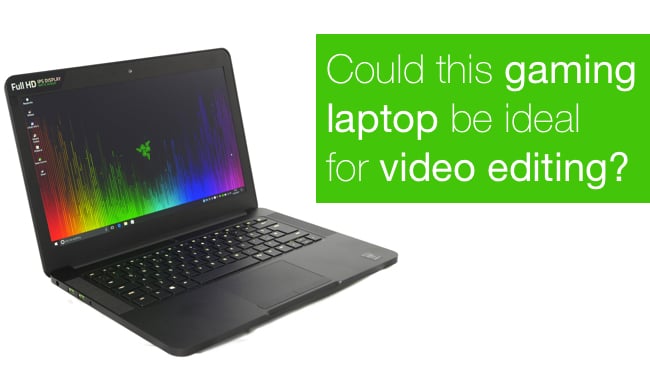
At anywhere between $1800 and $2700 the new Razer Blade laptop isn’t cheap, but this is one of those happy times when you very much get what you pay for: it is deeply impressive.
Razer seems to have taken a number of cues from Apple when it designed the Blade laptop. The chassis is machined from a hunk of aluminium and the end result looks stunning and is slender, lightweight and stylish. Another, less fortunate, trend that Razer has followed is to name the original version of this laptop as Razer Blade and then to update the graphics from GTX 970M to GTX 1060 and keep the same name. So, in reality while this laptop looks exactly like the original Razer Blade it deserves to be known as the New Razer Blade or the Razer Blade GTX 1060 or perhaps the Razer Blade 2017.
When you order a Razer Blade most of the specification is fixed and unmoving. You get an Intel Core i7-6700HQ processor and 16GB of DDR4 memory to power the GTX 1060 graphics. You can choose whether the M.2 SSD is 256GB, 512GB or 1TB in capacity and whether you have the matte IPS Full HD screen with a resolution of 1920 x 1080 that came with our sample or step up to QHD resolution (3200 x 1800) with touchscreen that adds about £300 to the price.
The Full HD option makes icons and text look pretty teeny on the 14-inch screen so you will very likely have to use scaling on Windows 10 to make text legible. Clearly you will require a larger scaling factor with the QHD so the benefits are unclear unless you are editing photos in which case the extra pixels may help. If you are shooting movies at 4K you would obviously benefit from a 4K screen, however the pixels-per-inch figure would be sky high, and a move to a larger laptop would make better sense in any event.
Razer Blade first impressions
The first impression of the Razer Blade is a small, thin, lightweight laptop. When you look a bit more closely you see there aren’t many ports and connectors but what you get is all good stuff. In total you have three USB 3.0 ports, an HDMI 2.0 output, a combo audio jack and a 40Gbps Thunderbolt 3 port. These ports arranged on the two sides with nothing on the front or rear so everything is very easy to reach.
The chiclet keyboard is illuminated and has Razer Chroma support. Some of the lighting presets are completely over the top, however the more restrained presets are useful when you’re working in low light and you always have the option of turning the lighting off.
This may be childish but the illuminated Razer logo in the lid feels you are sticking two fingers up to the legion of Apple Mac Book users. When you’re on the move the glass touchpad feels good, however the mouse buttons are rather small. When you’re working at a desk you would be well advised to use an external mouse.
Performance is exactly as good as you would expect from the combination of Core i7, DDR4 RAM, SSD storage and GTX 1060 graphics. We have seen reports of Razer Blades that appear to suffer thermal throttling in the CPU. While we were able to push the internal temperature close to 90 degrees with synthetic stress tests we never actually hit that mark and experienced no problems. Temperatures in regular use are significantly lower.
It is worth pointing out the air intakes for the two heatpipe/fan systems are on the underside so if you were to carelessly place the Razer Blade on soft furnishings it might end badly. The cooling fans are audible but stop short of being annoying.
Overall we were deeply impressed. It looks superb, feels great and works impressively well. The price is a bit steep but reflects the quality of the hardware and represents decent value for money, as you can see from the spec below. Mac users will probably stick with the software they know, but Windows users should certainly give the New Razer Blade some consideration.
The New Razer Blade specification
Intel Core i7-6700HQ Quad-Core Processor (2.6GHz/3.5GHz)
Nvidia GeForce GTX 1060 (6GB GDDR5 VRAM)
16GB DDR4-2133 MHz System Memory
1TB Samsung PM961 PCIe M.2 SSD
14.0-in. IGZO QHD+, 3200x1800, capacitive multi-touch / 14.0-in. IPS Full HD Matte, 1,920x1,080 options
Anti-ghosting keyboard with per-key lighting powered by Razer Chroma
Killer Wireless-AC 1535 (802.11a/b/g/n/ac + Bluetooth 4.1)
Thunderbolt 3 (USB-C)
USB 3.0 port x3 (SuperSpeed)
HDMI 2.0 video and audio output
3.5 mm headphone/microphone combo port
Built-in 2Megapixel webcam
Built-in stereo speakers
Array microphone
Dolby Digital Plus Home Theatre Edition
7.1 Codec support (via HDMI)
Trusted Platform Module (TPM 2.0) security chip embedded
Razer Synapse enabled with programmable keyboard, track pad, back lighting, and fan control
Kensington security slot
Compact 165W power adapter
Built-in 70Wh rechargeable lithium-ion polymer battery
Windows 10 64-bit
Approx. Size: 17.9 mm (Height) x 345 mm (Width) x 235 mm (Depth)
Approx. Weight (QHD+) 1.95 kg
Approx. Weight (Full HD) 1.89 kg